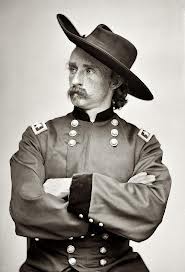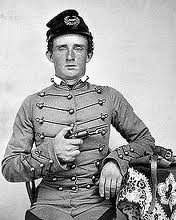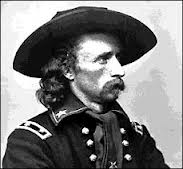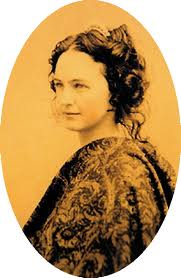 Custer Comical Clown or Military Megalomaniac? Another Boy General, Custer was definitely “a horse of a different color.” Always yearning for a higher posting in life, Custer based his personal performance and persona on what other’s perceptions might be. He was a colorful and aggressive, mounted officer, a hero to the press, the heart-throb of many female readers, an inspiration to male youth of the era. There is always a fine line between genius and insanity, Custer walked this line, luckily, for most of his short military career and eventually his self-centered and vain glorious bent led to his early demise and infamy.
Custer Comical Clown or Military Megalomaniac? Another Boy General, Custer was definitely “a horse of a different color.” Always yearning for a higher posting in life, Custer based his personal performance and persona on what other’s perceptions might be. He was a colorful and aggressive, mounted officer, a hero to the press, the heart-throb of many female readers, an inspiration to male youth of the era. There is always a fine line between genius and insanity, Custer walked this line, luckily, for most of his short military career and eventually his self-centered and vain glorious bent led to his early demise and infamy.
George Armstrong Custer, born in 1839, a native of Ohio, was raised in Michigan. The son of a blacksmith, Custer spent his entire life trying to distance himself from his meager and humble roots. He finished high school in Michigan and returned to Ohio to teach school.  Apparently this didn’t suit Custer, so he applied to the United States Military Academy and was admitted in 1858. Academy life could have been a dismal failure for the youthful aspirant, but with the Civil War looming, his knack for being in the right place, at the right time, held his West Point career in good stead. Officially in the class of 1862, Custer and his class graduated early in 1861, with George Armstrong Custer finishing dead last, 34th out of 34 cadets. Normally such a dismal record would have landed Custer in a remote posting, however with the beginning of the Civil War and the need for trained officers, Custer was commissioned a 2nd Lieutenant, assigned to the 2nd U.S. Cavalry.
Apparently this didn’t suit Custer, so he applied to the United States Military Academy and was admitted in 1858. Academy life could have been a dismal failure for the youthful aspirant, but with the Civil War looming, his knack for being in the right place, at the right time, held his West Point career in good stead. Officially in the class of 1862, Custer and his class graduated early in 1861, with George Armstrong Custer finishing dead last, 34th out of 34 cadets. Normally such a dismal record would have landed Custer in a remote posting, however with the beginning of the Civil War and the need for trained officers, Custer was commissioned a 2nd Lieutenant, assigned to the 2nd U.S. Cavalry.
 Custer saw his initial action at the First Battle of Manassas, as a messenger between Generals Scott and McDowell, was next assigned to the 5th Cavalry and then as aid-de-camp to McClellan. While with McClellan, Custer developed his love for the press and realized how his public persona could enhance his military career. Custer’s flamboyant leadership, known for his red scarf and flowing, blonde, perfumed locks, made him perfect newspaper fodder and either tailored him the dandy of the media or infuriated his subordinates and superiors alike. His battlefield daring and do, his victories or humiliations, gained Custer serious rank and he became the youngest of field general officers under General Pleasonton’s leadership who was Cavalry Commander of the Army of the Potomac.
Custer saw his initial action at the First Battle of Manassas, as a messenger between Generals Scott and McDowell, was next assigned to the 5th Cavalry and then as aid-de-camp to McClellan. While with McClellan, Custer developed his love for the press and realized how his public persona could enhance his military career. Custer’s flamboyant leadership, known for his red scarf and flowing, blonde, perfumed locks, made him perfect newspaper fodder and either tailored him the dandy of the media or infuriated his subordinates and superiors alike. His battlefield daring and do, his victories or humiliations, gained Custer serious rank and he became the youngest of field general officers under General Pleasonton’s leadership who was Cavalry Commander of the Army of the Potomac.
As a field commander, Custer, who loved the glory of leading from the front, was in the thick of the fray at the engagements at, Aldie, Gettysburg, Trevilian Station, Third Winchester, Cedar Creek, Sailor’s Creek, Appomattox Station, and was present and witnessed Lee’s surrender at Appomattox Court House. Luck was a term that Custer used to describe much of his battlefield success, however the death rate of his troopers was appalling, even for Civil War standards.
 Custer, like another Boy General, George B. McClellan, was fortunate enough to marry above his station and chose as his bride, Elizabeth Bacon. They married in 1864 and like McClellan’s wife, Custer’s became his greatest and most influential advocate. Even after her husband’s death, Elizabeth lobbied for her Autie’s fame, recognition and unblemished legacy.
Custer, like another Boy General, George B. McClellan, was fortunate enough to marry above his station and chose as his bride, Elizabeth Bacon. They married in 1864 and like McClellan’s wife, Custer’s became his greatest and most influential advocate. Even after her husband’s death, Elizabeth lobbied for her Autie’s fame, recognition and unblemished legacy.
All militaries thrive on young and naive officers like Custer. Their bluster, can be mistaken for courage, their audaciousness for greatness and their rash and foolish decisions for unparalleled leadership. Custer’s closest brush with lasting fame, was his brother Thomas, who truly, without question, commanded respect and a lasting renown, being awarded 2 Medals of Honor, for his bravery, during separate engagements of the Civil War.
After the Civil War, George Armstrong Custer, was posted to command a unit in Texas. His troopers were tired of service, wanted to be discharged and just go home. Custer bored with reconstruction and no publicity, demanded a strict discipline and brutal military regimen, that almost led to his assassination by his own troops.
Custer’s legacy is fraught with vicious truths, rumor, innuendo and Native American atrocities. The questions are still asked, whether Custer was just a Comical Clown or a Military Megalomaniac.
Bummer


My answer is yes – he was both. He was an effective leader of men yet he was a glory hound. Also, I read in Son of the Morning Star (one of the greatest history books I’ve ever read) that he rode away from Appomattox after Lee’s surrender with the table on which the general signed the document balanced on his head. Custer was childish yet a born leader of men. He’s a bit like an immature Douglas McArthur.
Louis,
“Morning Star” is a great read. Love the line in the movie “Patton” where the two G.I.’s are discussing the General. “There goes old blood and guts!” “Yeah, our blood and guts and his glory”! Something close to that. McArthur and Patton were both 18th or 19th century generals that morphed into 20th century conflicts. Maybe even Storm’n Norman. War has always been about money, power and politics. There’s no room for heroes or great Generals. Most are too focused, to be electable. They normally won’t play the role.
Bummer